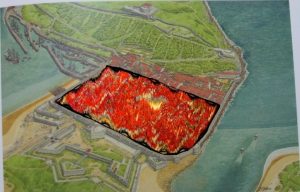Leith Hay cuenta en su Historia de la guerra de la Península (A Narrative of the Peninsular war. Leith Hay. (404)), la impresión que le produjo su visita a la ciudad en la mañana del 2 de septiembre de 1813:
“Ascendí la brecha y seguí la cortina, que presentaba un aspecto de indescriptible horror y destrucción. El calor de las casas ardientes era excesivo; de entre la masa de fuego salía aintervalos el ruido que hacían los soldados aún ocupados en aumentar las miserias acumuladas sobre la ciudad.
Nunca en los anales de la guerra hubo un caso de más completa aniquilación que el de San Sebastián.”
(Cuenta de agravios, San Sebastián, 20 de julio 1824. Archivo Municipal Sec. E. Neg. 5, III, Lib 2, Exp. 5, Núm 1. Historia de la reconstrucción de San Sebastián. Miguel Artola 1963. Ed. Ayuntamiento de San Sebastián, pág 22.)
A Narrative of the Peninsular war. Leith Hay. (404)
“Having walked up the face of the breach, I proceeded along the curtain, which presented a scene of indescribable havoc and destruction. The heat from the blazing houses was excessive; and from the midst of this mass of fire was at intervals to be heard, the noise created by soldiers still busied in adding to the miseries that had overtaken the devoted town.
Never was there in the annals of war a more decided case of annihilation than that of San Sebastian : the buildings all having communication, and being very closely arranged, ensured the conflagration becoming general; roofs falling, and the crashing of ruined walls that rolled down, and, in some cases, blocked up the passage in the streets, it was rendered more impressive from the obscurity occasioned even at midday by the dense cloud of smoke that shrouded this scene of ruin and desolation.” 404



Pingback: Donostia 1813 genozidioa Akiles Troia, Jerusalen, Numancia, Sagunto, Cartago, Mosku eta Gernika | Donostia ke ta su 1813 kultura 2013